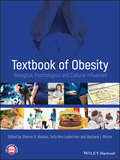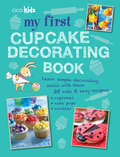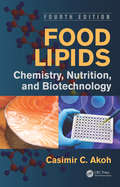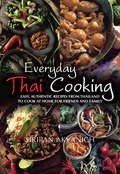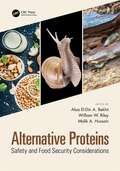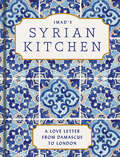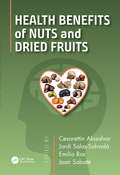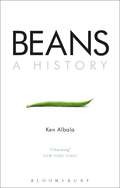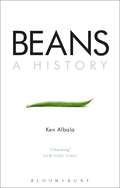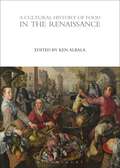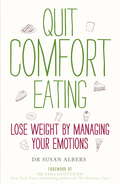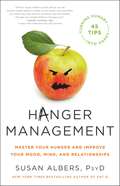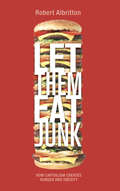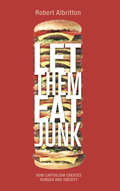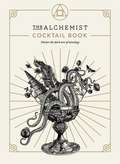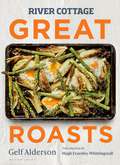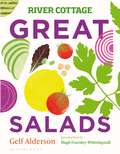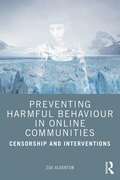- Table View
- List View
Textbook of Obesity: Biological, Psychological and Cultural Influences
by Sharon Akabas Sally Ann Lederman Barbara J. MooreTextbook of Obesity is designed to cover all of the essential elements concerning the etiology, prevention and treatment of obesity suitable for students in nutrition, dietetics and health science courses. Providing core knowledge for students is an essential and urgent requirement to ensure that those graduating will be properly equipped to deal with the high prevalence of overweight and obesity, currently affecting almost two-thirds of the population of the USA and with prevalence in much of the rest of the world rapidly catching up. This landmark text is organized into 5 parts comprising 27 chapters, each carefully written in a user-friendly style by experts in the area. Part I helps the reader to understand the scope and complexity of the problem of obesity. Part II focuses on obesity etiology. Part III examines the health consequences of obesity for both children and adults. Part IV discusses the challenge of assessing obesity in humans and offers insights into community factors that influence the risk of obesity. Finally, Part V dedicates 13 chapters to a discussion of a wide variety of obesity prevention and treatment interventions that are currently in use. Textbook of Obesity is an essential purchase for students and the many health professionals dealing with obesity on a day-to-day basis. A dedicated companion website features an extensive bank of questions and answers for readers to test their understanding, and all of the book’s illustrations for instructors to download: www.wiley.com/go/akabas/obesity
Textbook of Obesity: Biological, Psychological and Cultural Influences
by Sharon R. Akabas Sally Ann Lederman Barbara J. MooreTextbook of Obesity is designed to cover all of the essential elements concerning the etiology, prevention and treatment of obesity suitable for students in nutrition, dietetics and health science courses. Providing core knowledge for students is an essential and urgent requirement to ensure that those graduating will be properly equipped to deal with the high prevalence of overweight and obesity, currently affecting almost two-thirds of the population of the USA and with prevalence in much of the rest of the world rapidly catching up. This landmark text is organized into 5 parts comprising 27 chapters, each carefully written in a user-friendly style by experts in the area. Part I helps the reader to understand the scope and complexity of the problem of obesity. Part II focuses on obesity etiology. Part III examines the health consequences of obesity for both children and adults. Part IV discusses the challenge of assessing obesity in humans and offers insights into community factors that influence the risk of obesity. Finally, Part V dedicates 13 chapters to a discussion of a wide variety of obesity prevention and treatment interventions that are currently in use. Textbook of Obesity is an essential purchase for students and the many health professionals dealing with obesity on a day-to-day basis. A dedicated companion website features an extensive bank of questions and answers for readers to test their understanding, and all of the book’s illustrations for instructors to download: www.wiley.com/go/akabas/obesity
My First Cupcake Decorating Book: 35 recipes for decorating cupcakes, cookies and cake pops for children aged 7 years +
by Susan AkassBudding bakers will love these 35 recipes for making super-cute cakes! You'll learn how to make delicious cupcakes, cookies, cake pops and more - and transform them into fantastic creations. In Cool Cupcakes, make pink piggy cupcakes, classic butterfly cakes, pretty spotty cupcakes and more. The next chapter, Crazy Cookies, gives you ideas for creating ladybird cookies and pretty star cookies, as well as for gingerbread - including gingerbread families, animals and a village. Then have a go at the Brilliant Brownies and Cake Pops - from adorable penguin pops to delicious brownie pops and cute brownie owls. Finally, take your pick from the Novelty Cakes, where there are super snowmen, under the sea mini cakes and honey flake crunchies. There are basic recipes so that you can make the cakes in any flavour you want, and a techniques section that will teach you all you'll need to know, such as how to pipe icing and how to make shapes out of marzipan. All the projects are easy to follow with adorable artworks to guide you along the way; plus, each one has a grade so you can start with the easiest and then move on as your decorating skills improve.
Food Lipids: Chemistry, Nutrition, and Biotechnology, Fourth Edition
by Casimir C. AkohMaintaining the high standards that made the previous editions such well-respected and widely used references, Food Lipids: Chemistry, Nutrition, and Biotechnology, Fourth Edition provides a new look at lipid oxidation and highlights recent findings and research. Always representative of the current state of lipid science, this edition provides 16 new chapters and 21 updated chapters, written by leading international experts, that reflect the latest advances in technology and studies of food lipids.New chapters Analysis of Fatty Acid Positional Distribution in Triacylglycerol Physical Characterization of Fats and Oils Processing and Modification Technologies for Edible Oils and Fats Crystallization Behavior of Fats: Effect of Processing Conditions Enzymatic Purification and Enrichment and Purification of Polyunsaturated Fatty Acids and Conjugated Linoleic Acid Isomers Microbial Lipid Production Food Applications of Lipids Encapsulation Technologies for Lipids Rethinking Lipid Oxidation Digestion, Absorption and Metabolism of Lipids Omega-3 Polyunsaturated Fatty Acids and Health Brain Lipids in Health and Disease Biotechnologically Enriched Cereals with PUFAs in Ruminant and Chicken Nutrition Enzyme-Catalyzed Production of Lipid Based Esters for the Food Industry: Emerging Process and Technology Production of Edible Oils Through Metabolic Engineering Genetically Engineered Cereals for Production of Polyunsaturated Fatty Acids The most comprehensive and relevant treatment of food lipids available, this book highlights the role of dietary fats in foods, human health, and disease. Divided into five parts, it begins with the chemistry and properties of food lipids covering nomenclature and classification, extraction and analysis, and chemistry and function. Part II addresses processing and food applications including modification technologies, microbial production of lipids, crystallization behavior, chemical interesterification, purification, and encapsulation technologies. The third part covers oxidation, measurements, and antioxidants. Part IV explores the myriad interactions of lipids in nutrition and health with information on heart disease, obesity, and cancer, with a new chapter dedicated to brain lipids. Part V continues with contributions on biotechnology and biochemistry including a chapter on the metabolic engineering of edible oils.
Food Lipids: Chemistry, Nutrition, and Biotechnology, Fourth Edition
by Casimir C. AkohMaintaining the high standards that made the previous editions such well-respected and widely used references, Food Lipids: Chemistry, Nutrition, and Biotechnology, Fourth Edition provides a new look at lipid oxidation and highlights recent findings and research. Always representative of the current state of lipid science, this edition provides 16 new chapters and 21 updated chapters, written by leading international experts, that reflect the latest advances in technology and studies of food lipids.New chapters Analysis of Fatty Acid Positional Distribution in Triacylglycerol Physical Characterization of Fats and Oils Processing and Modification Technologies for Edible Oils and Fats Crystallization Behavior of Fats: Effect of Processing Conditions Enzymatic Purification and Enrichment and Purification of Polyunsaturated Fatty Acids and Conjugated Linoleic Acid Isomers Microbial Lipid Production Food Applications of Lipids Encapsulation Technologies for Lipids Rethinking Lipid Oxidation Digestion, Absorption and Metabolism of Lipids Omega-3 Polyunsaturated Fatty Acids and Health Brain Lipids in Health and Disease Biotechnologically Enriched Cereals with PUFAs in Ruminant and Chicken Nutrition Enzyme-Catalyzed Production of Lipid Based Esters for the Food Industry: Emerging Process and Technology Production of Edible Oils Through Metabolic Engineering Genetically Engineered Cereals for Production of Polyunsaturated Fatty Acids The most comprehensive and relevant treatment of food lipids available, this book highlights the role of dietary fats in foods, human health, and disease. Divided into five parts, it begins with the chemistry and properties of food lipids covering nomenclature and classification, extraction and analysis, and chemistry and function. Part II addresses processing and food applications including modification technologies, microbial production of lipids, crystallization behavior, chemical interesterification, purification, and encapsulation technologies. The third part covers oxidation, measurements, and antioxidants. Part IV explores the myriad interactions of lipids in nutrition and health with information on heart disease, obesity, and cancer, with a new chapter dedicated to brain lipids. Part V continues with contributions on biotechnology and biochemistry including a chapter on the metabolic engineering of edible oils.
Everyday Thai Cooking: Easy, Authentic Recipes from Thailand to Cook at Home for Friends and Family (William Lorimer)
by Siripan AkvanichEveryday Thai Cooking brings you the secrets of cooking delicious Thai food straight from Thailand. Author Siripan Akvanich draws on her years of experience of cooking for her restaurant customers in Thailand to enable you to create authentic Thai dishes, ranging from curries and meat and fish dishes to wonderful Thai desserts. With clear instructions and insider tips, Siripan helps you bring these dishes - many of them traditional family recipes - to life and shows you how to make them a-roi (delicious)! Everyday Thai Cooking shows you how straightforward it can be to cook wonderful Thai food, and how you can juggle the array of tasty and spicy (if you want) flavours to get just the right taste.
Alternative Proteins: Safety and Food Security Considerations
by Alaa El-Din A. BekhitIn the last decade, there has been substantial research dedicated towards prospecting physiochemical, nutritional and health properties of novel protein sources. In addition to being driven by predictions of increased population and lack of a parallel increase in traditional protein sources, main drivers for the rise in novel proteins/ novel foods research activities is linked to significant changes in young consumers’ attitudes toward red meat consumption and their interest in new alternative protein products. Alternative Proteins: Safety and Food Security Considerations presents up-to-date information on alternative proteins from non-meat sources and examines their nutritional and functional roles as food sources and ingredients. Emphasis is placed on the safety of these novel proteins and an evaluation of their potential contribution to food security. Motivations for novel proteins and restrictions for their use are also discussed. Key Features: Explains potential improvements to alternative proteins through the employment of novel processing techniques. Contains the first review on keratin as an alternative protein source. Explores first comprehensive evaluation of the religious aspects of novel proteins. Describes methods for the detection and evaluation of health hazards. Discusses guidelines, regulatory issues and recommendations for food safety Additionally, this book covers fundamental and recent developments in the production of alternative proteins, and examines safety and consumer acceptability wherever information is available. The sources and processing options for alternative proteins and their impact on final product characteristics are also covered. A collective contribution from international researchers who are active in their field of research and have made significant contributions to the the food sciences, this book is beneficial to any researcher interested in the the food science and safety of alternative proteins.
Imad’s Syrian Kitchen
by Imad AlarnabA bustling, vibrant tour of flavour-packed Syrian dishes 90 sensational recipes celebrating the flavours of Syria, that can easily be made in the comfort of your own home
Health Benefits of Nuts and Dried Fruits
by Cesarettin Alasalvar Jordi Salas-Salvadó Emilio Ros Joan SabatéNuts and dried fruits are part of our daily diet. They are consumed whole or as ingredients of many food products such as muffins, cereals, chocolates, energy bars, breads, and cookies, among others. Health Benefits of Nuts and Dried Fruits provides a comprehensive overview of the literature on the health benefits of nuts and dried fruits. The book summarizes the current state of knowledge in key research areas and provides ideas for future scientific research and product development. Nuts, a term that comprises tree nuts and peanuts, are highly nutritious, containing health-promoting macronutrients, micronutrients, vitamins, and bioactive phytochemicals; they are one of the edible foods with the highest content in antioxidants. The consumption of nuts is recognized for its health-promoting properties, which ranges from a consistent cholesterol-lowering effect in clinical trials to a robust association with reduced risk of cardiovascular disease and all-cause mortality in prospective studies. In spite of the high energy content of nuts, there is no evidence that their frequent consumption promotes obesity, and they may even help control it. Dried fruits, which serve as important healthful snacks worldwide, are nutritionally equivalent to fresh fruits while providing all of their bioactive components in concentrated form. While the evidence level concerning the health effects of dried fruits lags behind that on nuts, it suggests that individuals who consume dried fruits regularly have a lower risk of cardiovascular disease, obesity, and other non-communicable diseases. Main features of the book concerning nuts and dried fruits: • Provides detailed information on health effects • Highlights current regulation and health claims • Provides updated dietary recommendations • Describes nutrient absorption and metabolism • Discusses mechanisms implicated in the health effects Although this book is intended primarily as a reference, by comprehensively reviewing the current state of knowledge it can guide future research on the topic. Among others, food scientists, biochemists, nutritionists, health professionals, decision makers, and regulatory agencies can draw much benefit from its contents. Hopefully, it will help in public health strategies to promote healthy aging and improve population wellbeing.
Health Benefits of Nuts and Dried Fruits
by Cesarettin Alasalvar Jordi Salas-Salvado Emilio Ros Joan SabateNuts and dried fruits are part of our daily diet. They are consumed whole or as ingredients of many food products such as muffins, cereals, chocolates, energy bars, breads, and cookies, among others. Health Benefits of Nuts and Dried Fruits provides a comprehensive overview of the literature on the health benefits of nuts and dried fruits. The book summarizes the current state of knowledge in key research areas and provides ideas for future scientific research and product development. Nuts, a term that comprises tree nuts and peanuts, are highly nutritious, containing health-promoting macronutrients, micronutrients, vitamins, and bioactive phytochemicals; they are one of the edible foods with the highest content in antioxidants. The consumption of nuts is recognized for its health-promoting properties, which ranges from a consistent cholesterol-lowering effect in clinical trials to a robust association with reduced risk of cardiovascular disease and all-cause mortality in prospective studies. In spite of the high energy content of nuts, there is no evidence that their frequent consumption promotes obesity, and they may even help control it. Dried fruits, which serve as important healthful snacks worldwide, are nutritionally equivalent to fresh fruits while providing all of their bioactive components in concentrated form. While the evidence level concerning the health effects of dried fruits lags behind that on nuts, it suggests that individuals who consume dried fruits regularly have a lower risk of cardiovascular disease, obesity, and other non-communicable diseases. Main features of the book concerning nuts and dried fruits: • Provides detailed information on health effects • Highlights current regulation and health claims • Provides updated dietary recommendations • Describes nutrient absorption and metabolism • Discusses mechanisms implicated in the health effects Although this book is intended primarily as a reference, by comprehensively reviewing the current state of knowledge it can guide future research on the topic. Among others, food scientists, biochemists, nutritionists, health professionals, decision makers, and regulatory agencies can draw much benefit from its contents. Hopefully, it will help in public health strategies to promote healthy aging and improve population wellbeing.
Beans: A History
by Ken AlbalaThis is the story of the bean, the staple food cultivated by humans for over 10,000 years. From the lentil to the soybean, every civilization on the planet has cultivated its own species of bean. The humble bean has always attracted attention - from Pythagoras' notion that the bean hosted a human soul to St. Jerome's indictment against bean-eating in convents (because they "tickle the genitals"), to current research into the deadly toxins contained in the most commonly eaten beans. Over time, the bean has been both scorned as "poor man's meat" and praised as health-giving, even patriotic. Attitudes to this most basic of foodstuffs have always revealed a great deal about a society. Featuring a new preface from author Ken Albala, Beans: A History takes the reader on a fascinating journey across cuisines and cultures.
Beans: A History
by Ken AlbalaThis is the story of the bean, the staple food cultivated by humans for over 10,000 years. From the lentil to the soybean, every civilization on the planet has cultivated its own species of bean. The humble bean has always attracted attention - from Pythagoras' notion that the bean hosted a human soul to St. Jerome's indictment against bean-eating in convents (because they "tickle the genitals"), to current research into the deadly toxins contained in the most commonly eaten beans. Over time, the bean has been both scorned as "poor man's meat" and praised as health-giving, even patriotic. Attitudes to this most basic of foodstuffs have always revealed a great deal about a society. Featuring a new preface from author Ken Albala, Beans: A History takes the reader on a fascinating journey across cuisines and cultures.
A Cultural History of Food in the Renaissance (The Cultural Histories Series)
by Ken AlbalaFood and attitudes toward it were transformed in Renaissance Europe. The period between 1300 and 1600 saw the discovery of the New World and the cultivation of new foodstuffs, as well as the efflorescence of culinary literature in European courts and eventually in the popular press, and most importantly the transformation of the economy on a global scale. Food became the object of rigorous investigation among physicians, theologians, agronomists and even poets and artists. Concern with eating was, in fact, central to the cultural dynamism we now recognize as the Renaissance.A Cultural History of Food in the Renaissance presents an overview of the period with essays on food production, food systems, food security, safety and crises, food and politics, eating out, professional cooking, kitchens and service work, family and domesticity, body and soul, representations of food, and developments in food production and consumption globally.
Quit Comfort Eating: Lose weight by managing your emotions
by Dr Susan Albers PsyDWhy can't so many smart people lose weight? The answer: low emotional intelligence can lock you into a vicious cycle of dieting failure. Dr Susan Albers, accomplished expert in emotional eating and weight loss, has created an accessible three-step plan that will teach you how to combat the most common emotional barriers to weight loss. Her EAT plan tackles comfort eating, the pressure of social eating so common in offices, stress-triggered eating, eating to avoid emotional problems and using food to numb trauma.Drawing on mindfulness, Dr Albers provides 25 tools and techniques readers can use to tailor their eating to the demands of their own lives, their preferences and moods. Reverse a lifetime of overeating and comfort bingeing with Quit Comfort Eating.
Hanger Management: Master Your Hunger and Improve Your Mood, Mind, and Relationships
by Susan AlbersThe complete program for mastering your "hanger," from mindful-eating pioneer Dr. Susan Albers -- with 45 tips to turn hanger into happiness. It happens to all of us. One minute you're happily going about your day, and a few seconds later you're a snappy, illogical version of yourself. The culprit? Hanger. We're living busier lives than ever before, and when we forget to eat -- or accidentally overeat -- hunger can make us angry, unreasonable, and dull, with big impacts on our emotional and psychological well being. And hanger can become a cycle. When we get too hungry, we're more likely to make food decisions we regret, which sets us up for another hanger crash later on. The good news: when we make better decisions about food, we think more clearly, connect better in our relationships, and improve our performance. Hanger Management is the book that can help you break this cycle and create healthy habits that fuel and empower you.In Hanger Management, New York Times bestselling author and clinical psychologist Susan Albers sheds light on the causes of hanger, and shares 45 of her best tips for managing it well. By learning to stay on top of your hunger cues, cultivating a better understanding of your appetite, and creating a better overall relationship with food, you'll become happier -- and healthier -- for life.
Hanger Management: Master Your Hunger and Improve Your Mood, Mind, and Relationships
by Susan AlbersThe complete program for mastering your "hanger," from mindful-eating pioneer Dr. Susan Albers -- with 45 tips to turn hanger into happiness. It happens to all of us. One minute you're happily going about your day, and a few seconds later you're a snappy, illogical version of yourself. The culprit? Hanger. We're living busier lives than ever before, and when we forget to eat -- or accidentally overeat -- hunger can make us angry, unreasonable, and dull, with big impacts on our emotional and psychological well being. And hanger can become a cycle. When we get too hungry, we're more likely to make food decisions we regret, which sets us up for another hanger crash later on. The good news: when we make better decisions about food, we think more clearly, connect better in our relationships, and improve our performance. Hanger Management is the book that can help you break this cycle and create healthy habits that fuel and empower you.In Hanger Management, New York Times bestselling author and clinical psychologist Susan Albers sheds light on the causes of hanger, and shares 45 of her best tips for managing it well. By learning to stay on top of your hunger cues, cultivating a better understanding of your appetite, and creating a better overall relationship with food, you'll become happier -- and healthier -- for life.
Let Them Eat Junk: How Capitalism Creates Hunger and Obesity
by Robert AlbrittonThis book to analyses the food industry from a Marxist perspective.*BR**BR*Let The Eat Junk argues that the capitalist system, far from delivering on the promise of cheap, nutritious food for all, has created a world where 25% of the world population are over-fed and 25% are hungry. This malnourishment of 50% of the world's population is explained systematically, a refreshing change from accounts that focus on cultural factors and individual greed. Robert Albritton details the economic relations and connections that have put us in a situation of simultaneous oversupply and undersupply of food.*BR**BR*This explosive book provides yet more evidence that the human cost of capitalism is much bigger than those in power will admit.
Let Them Eat Junk: How Capitalism Creates Hunger and Obesity
by Robert AlbrittonThis book to analyses the food industry from a Marxist perspective.*BR**BR*Let The Eat Junk argues that the capitalist system, far from delivering on the promise of cheap, nutritious food for all, has created a world where 25% of the world population are over-fed and 25% are hungry. This malnourishment of 50% of the world's population is explained systematically, a refreshing change from accounts that focus on cultural factors and individual greed. Robert Albritton details the economic relations and connections that have put us in a situation of simultaneous oversupply and undersupply of food.*BR**BR*This explosive book provides yet more evidence that the human cost of capitalism is much bigger than those in power will admit.
The Alchemist Cocktail Book: Master the dark arts of mixology
by The Alchemist100 spell-binding, crowd-pleasing cocktails.Work some magic at home with these original cocktail recipes from everyone's favourite experimental bar, The Alchemist. Elevate your mixology skills and bring some creativity to your bar cart with unique and show-stopping tipple time recipes, from their iconic Caramelised Rum Punch and Smokey Old Fashioned, to new takes on the cocktail classics. With chapters from Chemistry & Theatre, Twisted Classics and New Wave to Classics and Low & No Alcohol, The Alchemist Cocktail Book truly has something for everyone, from mixing novices to experienced bartenders. Bring some dramatic flair to your cocktail hour, with recipes including:Lavender DaiquiriPalomaRhubarb and Custard SourBananagroniMaple ManhattanCola Bottle LibreGrapefruit and Apricot Martini
River Cottage Great Roasts
by Gelf AldersonLet the oven do the work with these quick and simple ingredient-focussed recipes from the River Cottage kitchenIn River Cottage Great Roasts, all you will need are good ingredients, an oven and some simple bakeware to create easy weeknight dinners, showstopping Sunday roasts, fuss-free breakfasts, tea-time treats and indulgent puds. Often only requiring one roasting tin and minimal prep, these are recipes that let the oven do the hard work, and leave you with very little washing up:Spiced whole cauliflower with preserved lemon and yoghurtRoast mushrooms with beer and dumplingsPot roast brisket with orange and star aniseRipped potato oven chips with smoked chilli and roast garlic dipCreamy fish pieRoasted cherry and almond crumblePears with ginger and toffeeDivided into chapters like Breakfast & Brunch, One-tray Wonders, Sunday Roast, Super Sides and Puddings, the recipes all harness the power of the oven to transform everyday ingredients into their more deliciously caramelised, roasted counterparts.
River Cottage Great Roasts
by Gelf AldersonLet the oven do the work with these quick and simple ingredient-focussed recipes from the River Cottage kitchenIn River Cottage Great Roasts, all you will need are good ingredients, an oven and some simple bakeware to create easy weeknight dinners, showstopping Sunday roasts, fuss-free breakfasts, tea-time treats and indulgent puds. Often only requiring one roasting tin and minimal prep, these are recipes that let the oven do the hard work, and leave you with very little washing up:Spiced whole cauliflower with preserved lemon and yoghurtRoast mushrooms with beer and dumplingsPot roast brisket with orange and star aniseRipped potato oven chips with smoked chilli and roast garlic dipCreamy fish pieRoasted cherry and almond crumblePears with ginger and toffeeDivided into chapters like Breakfast & Brunch, One-tray Wonders, Sunday Roast, Super Sides and Puddings, the recipes all harness the power of the oven to transform everyday ingredients into their more deliciously caramelised, roasted counterparts.
River Cottage Great Salads
by Gelf AldersonGelf Alderson has spent years serving up original, veg-centric meals to delight the guests at River Cottage. His recipes redefine the idea of salad, as playful flavour pairings, clever techniques and vibrant dressings bring out the very best in seasonal produce. Divided into chapters such as Quick, Hearty, Spicy and Lunchbox, these recipes use everyday ingredients, and give plenty of suggestions for seasonal swaps and delicious alternatives. With minimal effort, you'll be serving up showstoppers such as Char-grilled cabbage, pickled pears, pesto and walnuts, Honey-glazed leftover belly perk with shredded summer veg and Roast asparagus, feta, almonds and sourdough croutons. There's also a whole chapter of dressings and pickles to enliven even a simple bowl of leaves. With more than 80 recipes and countless more variations to be explored, Gelf demonstrates how, with a bit of creativity and flair, simple ingredients can be combined to make truly great salads.
River Cottage Great Salads
by Gelf AldersonRiver Cottage head chef Gelf Alderson shows us how to create truly knockout salads using simple, seasonal ingredientsGelf Alderson has spent years serving up original, veg-centric meals to delight the guests at River Cottage. His recipes redefine the idea of salad, as playful flavour pairings, clever techniques and vibrant dressings bring out the very best in seasonal produce. With all the delicious summer fruit and veg coming into season right now, you'll be spoilt for choice with these tantalising recipes. Why not try:· Curried roots, pearled barley and parsley· Merguez roast squash, pears and chicory· Apple with toasted hazelnuts and lime· Leftover lamb, harissa and char-grilled peppers· Lentils with green herbs and lemonDivided into easy chapters like Quick, Hearty, Spicy and Lunchbox, these recipes use everyday ingredients, and give plenty of suggestions for seasonal swaps and delicious alternatives. With more than 80 recipes and countless more variations to be explored, Gelf demonstrates how, with a bit of creativity and flair, simple ingredients can be combined to make truly great salads.
Preventing Harmful Behaviour in Online Communities: Censorship and Interventions
by Zoe AldertonPreventing Harmful Behaviour in Online Communities explores the ethics and logistics of censoring problematic communications online that might encourage a person to engage in harmful behaviour. Using an approach based on theories of digital rhetoric and close primary source analysis, Zoe Alderton draws on group dynamics research in relation to the way in which some online communities foster negative and destructive ideas, encouraging community members to engage in practices including self-harm, disordered eating, and suicide. This book offers insight into the dangerous gap between the clinical community and caregivers versus the pro-anorexia and pro-self-harm communities – allowing caregivers or medical professionals to understand hidden online communities young people in their care may be part of. It delves into the often-unanticipated needs of those who band together to resist the healthcare community, suggesting practical ways to address their concerns and encourage healing. Chapters investigate the alarming ease with which ideas of self-harm can infect people through personal contact, community unease, or even fiction and song and the potential of the internet to transmit self-harmful ideas across countries and even periods of time. The book also outlines the real nature of harm-based communities online, examining both their appeal and dangers, while also examining self-censorship and intervention methods for dealing with harmful content online. Rather than pointing to punishment or censorship as best practice, the book offers constructive guidelines that outline a more holistic approach based on the validity of expressing negative mood and the creation of safe peer support networks, making it ideal reading for professionals protecting vulnerable people, as well as students and academics in psychology, mental health, and social care.
Preventing Harmful Behaviour in Online Communities: Censorship and Interventions
by Zoe AldertonPreventing Harmful Behaviour in Online Communities explores the ethics and logistics of censoring problematic communications online that might encourage a person to engage in harmful behaviour. Using an approach based on theories of digital rhetoric and close primary source analysis, Zoe Alderton draws on group dynamics research in relation to the way in which some online communities foster negative and destructive ideas, encouraging community members to engage in practices including self-harm, disordered eating, and suicide. This book offers insight into the dangerous gap between the clinical community and caregivers versus the pro-anorexia and pro-self-harm communities – allowing caregivers or medical professionals to understand hidden online communities young people in their care may be part of. It delves into the often-unanticipated needs of those who band together to resist the healthcare community, suggesting practical ways to address their concerns and encourage healing. Chapters investigate the alarming ease with which ideas of self-harm can infect people through personal contact, community unease, or even fiction and song and the potential of the internet to transmit self-harmful ideas across countries and even periods of time. The book also outlines the real nature of harm-based communities online, examining both their appeal and dangers, while also examining self-censorship and intervention methods for dealing with harmful content online. Rather than pointing to punishment or censorship as best practice, the book offers constructive guidelines that outline a more holistic approach based on the validity of expressing negative mood and the creation of safe peer support networks, making it ideal reading for professionals protecting vulnerable people, as well as students and academics in psychology, mental health, and social care.
